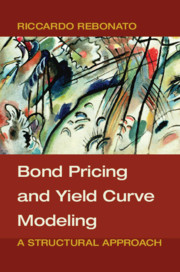Book contents
- Frontmatter
- Dedication
- Contents
- Acknowledgements
- Symbols and Abbreviations
- Part I The Foundations
- Part II The Building Blocks: A First Look
- Part III The Conditions of No-Arbitrage
- Part IV Solving the Models
- Part V The Value of Convexity
- Part VI Excess Returns
- 23 Excess Returns: Setting the Scene
- 24 Risk Premia, the Market Price of Risk and Expected Excess Returns
- 25 Excess Returns: Empirical Results
- 26 Excess Returns: The Recent Literature – I
- 27 Excess Returns: The Recent Literature – II
- 28 Why Is the Slope a Good Predictor?
- 29 The Spanning Problem Revisited
- Part VII What the Models Tell Us
- References
- Index
23 - Excess Returns: Setting the Scene
from Part VI - Excess Returns
Published online by Cambridge University Press: 25 May 2018
- Frontmatter
- Dedication
- Contents
- Acknowledgements
- Symbols and Abbreviations
- Part I The Foundations
- Part II The Building Blocks: A First Look
- Part III The Conditions of No-Arbitrage
- Part IV Solving the Models
- Part V The Value of Convexity
- Part VI Excess Returns
- 23 Excess Returns: Setting the Scene
- 24 Risk Premia, the Market Price of Risk and Expected Excess Returns
- 25 Excess Returns: Empirical Results
- 26 Excess Returns: The Recent Literature – I
- 27 Excess Returns: The Recent Literature – II
- 28 Why Is the Slope a Good Predictor?
- 29 The Spanning Problem Revisited
- Part VII What the Models Tell Us
- References
- Index
Summary
If the attractiveness of an economic hypothesis is measured by the number of papers which statistically reject it, the expectations theory of the term structure is a knockout.
Froot (1989)THE PURPOSE OF THIS CHAPTER
In this chapter we define precisely the local expectation hypothesis and excess returns, and we present several convenient expressions for this latter quantity. We do so both for nominal and for real returns.We show how the existence (or otherwise) of systematic excess returns from the strategy of ‘investing long and funding short’ is linked to the validity of the (local) expectation hypothesis.
THE (LOCAL) EXPECTATION HYPOTHESIS
As Sangvinatsos (2008) points out in his helpful review paper, the expectation hypothesis has spawned an immense literature, as the tongue-in-cheek quote by Froot that opens the chapter indicates. This is not surprising, because the expectation hypothesis relates to the evolution of yields, and is of direct relevance for the investment decisions of firms, for monetary policy, for portfolio allocation, and, less directly but not less importantly, for derivatives pricing and hedging. Above all, as Sangvinatsos (2008) says, the expectation hypothesis matters for our economic understanding.
Given its importance, researchers have begun looking into its validity as early as the late 1930s (see, eg, Macaulay (1938), Hicks (1939) and Lutz (1940)). Not surprisingly, the definition of the hypothesis provided in these early days (when Arbitrage Theory and stochastic discount factors were decades in the making) bears little apparent resemblance to the ‘modern’ definition. As Sangvinatsos (2008) says, ‘[t]hese [early versions of the hypothesis] were developed as a need of understanding the returns and yields on long versus short-term bonds, and the time series movements of the term structure. Later, researchers developed theoretical models that give rise to some of the hypothesized equations associated with the expectations hypothesis’.
Despite the apparent differences, the underlying concept (and, more importantly, the underlying economic concern) can be expressed in terms of the Local (or Pure) Expectation Hypothesis, and the Weak Expectation Hypothesis. Confusion is created because some authors speak of the Expectation Hypothesis with any qualification when they refer to the weak version, and other authors when they mean the local variety.
- Type
- Chapter
- Information
- Bond Pricing and Yield Curve ModelingA Structural Approach, pp. 415 - 430Publisher: Cambridge University PressPrint publication year: 2018



